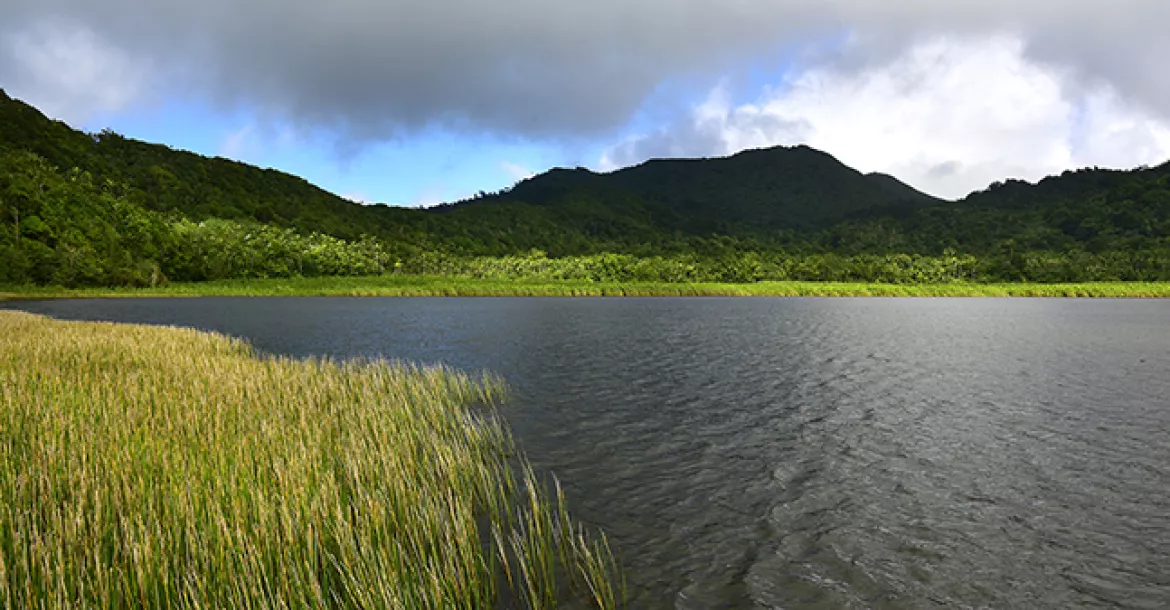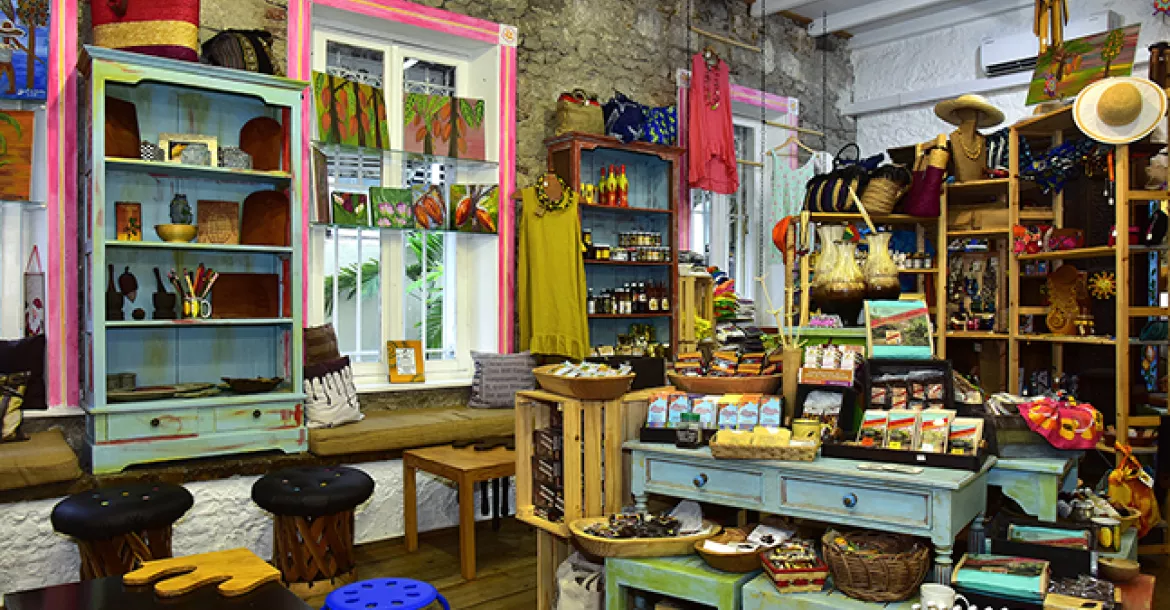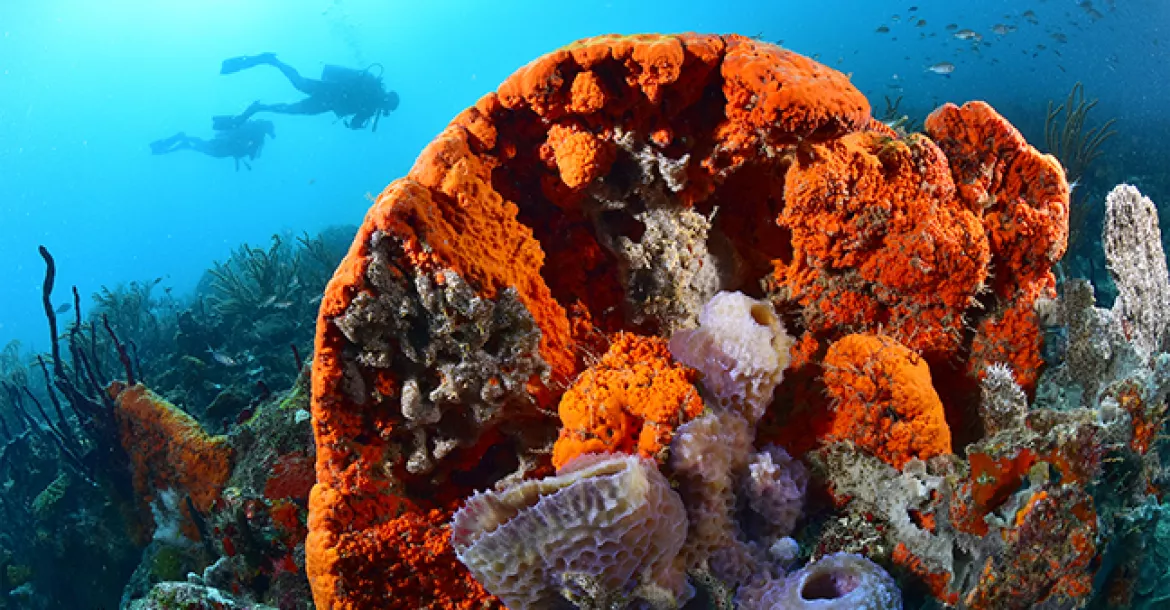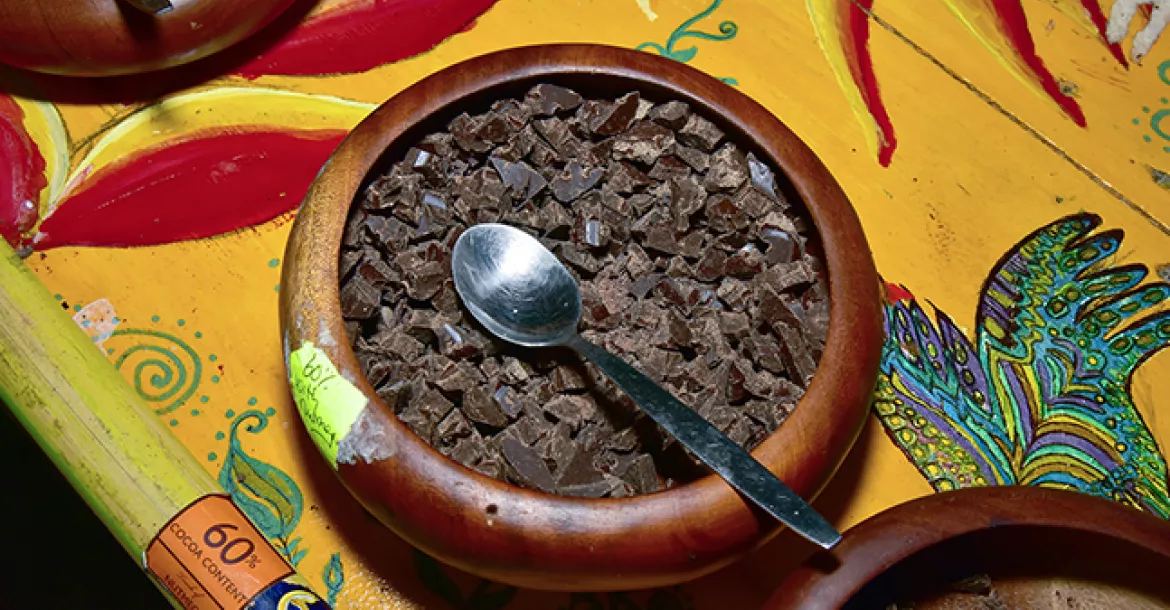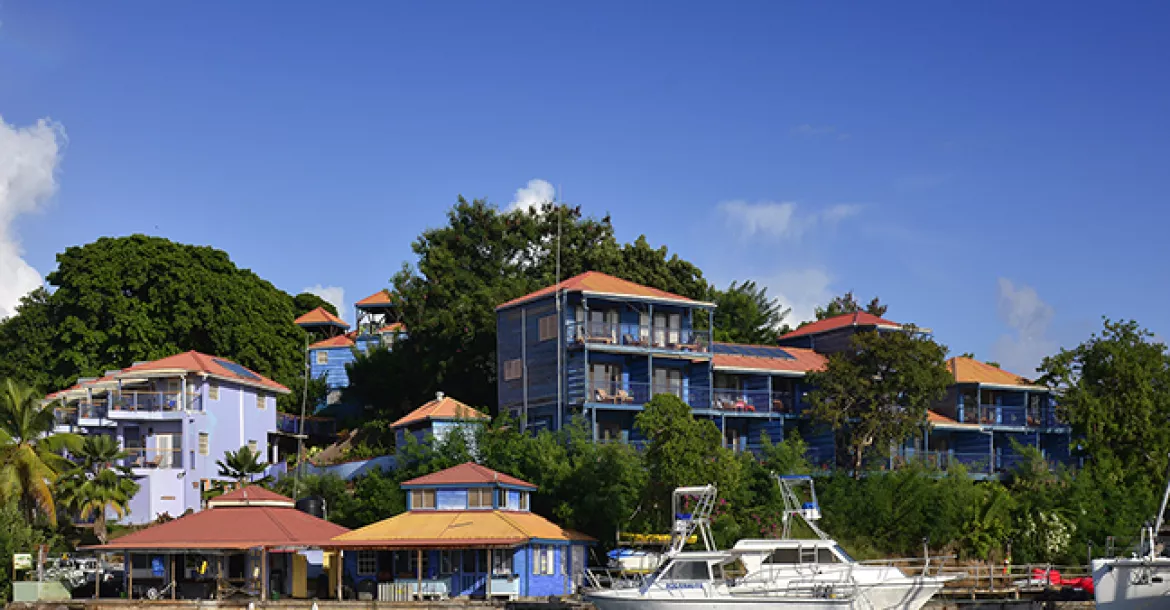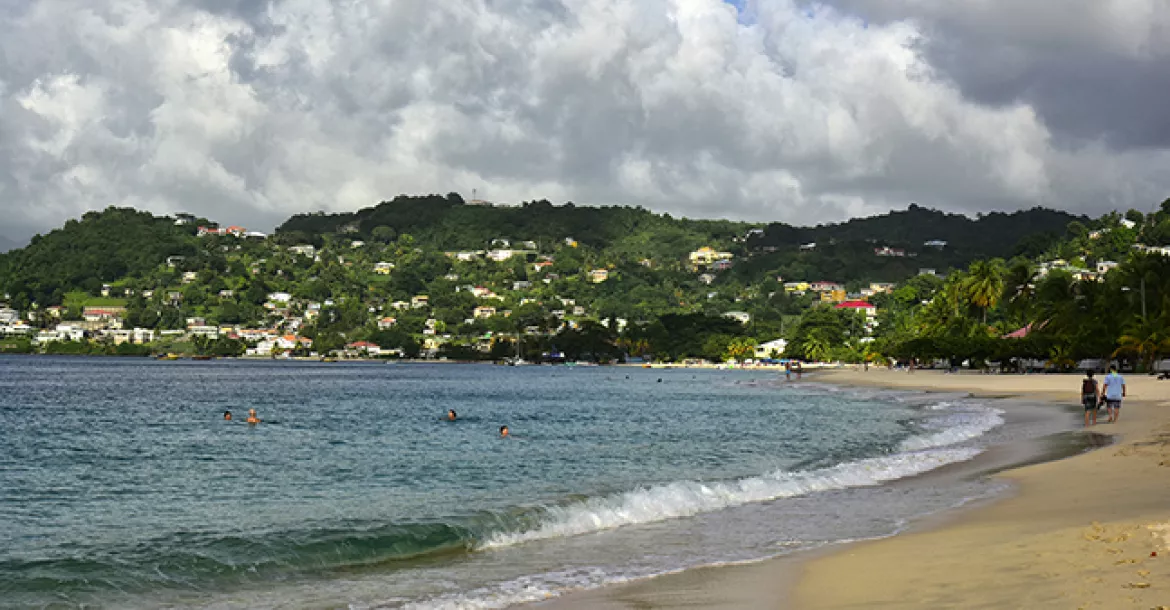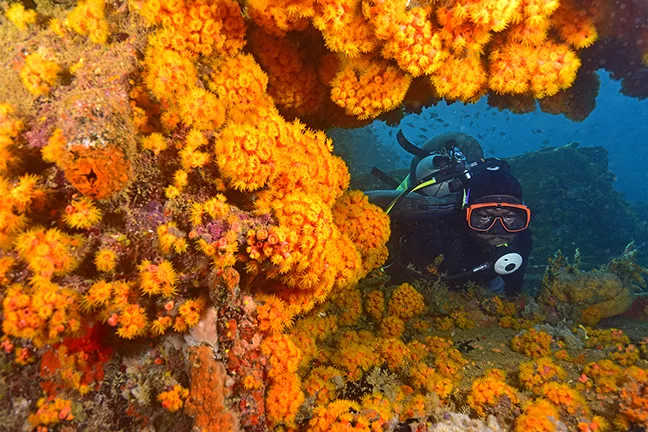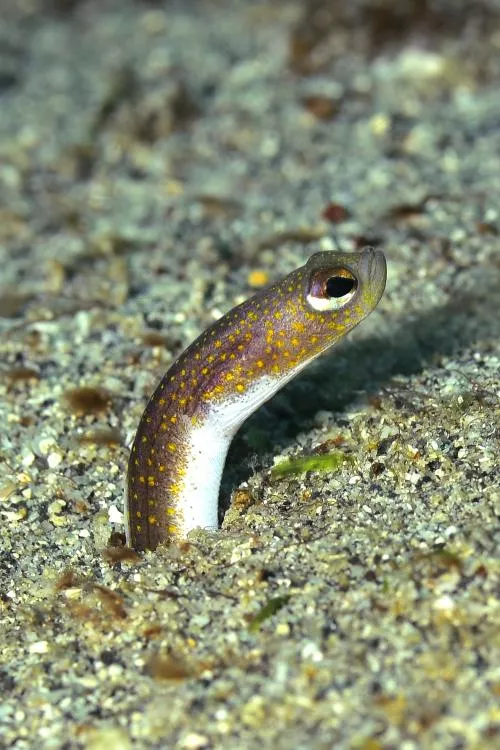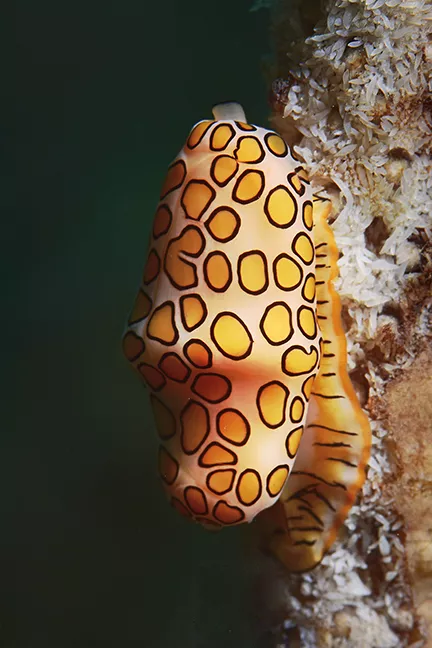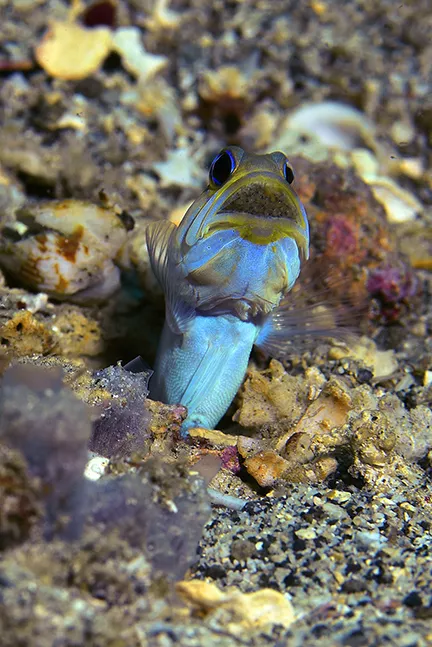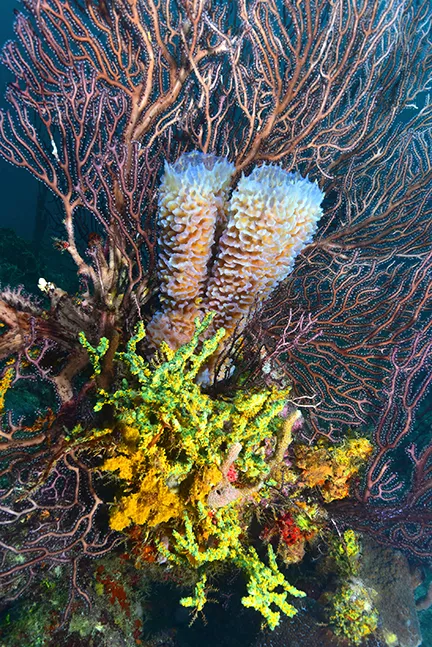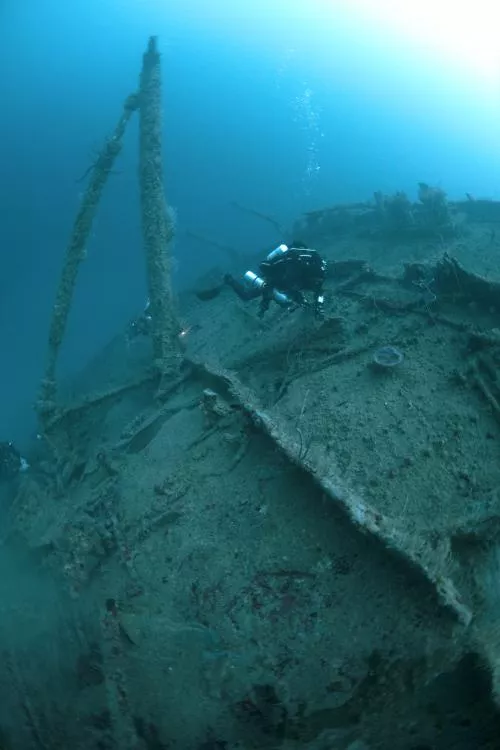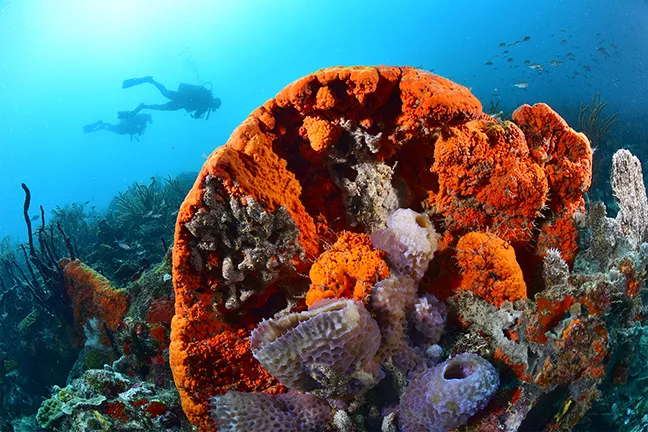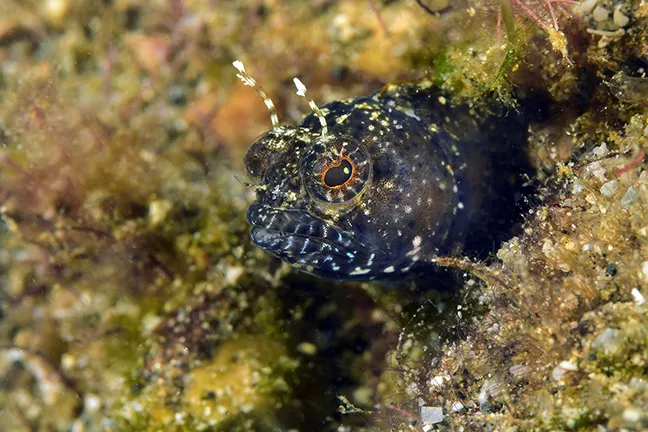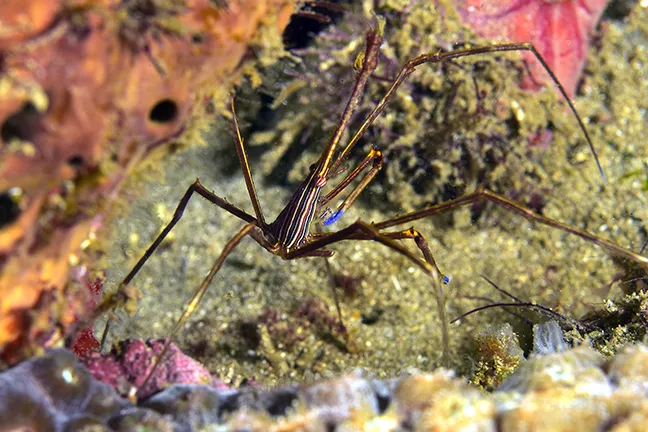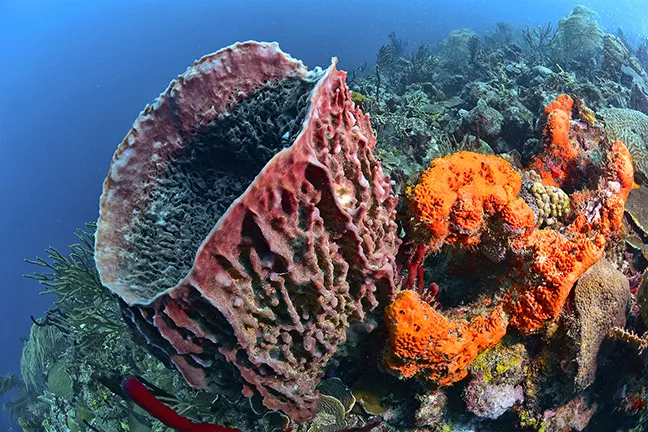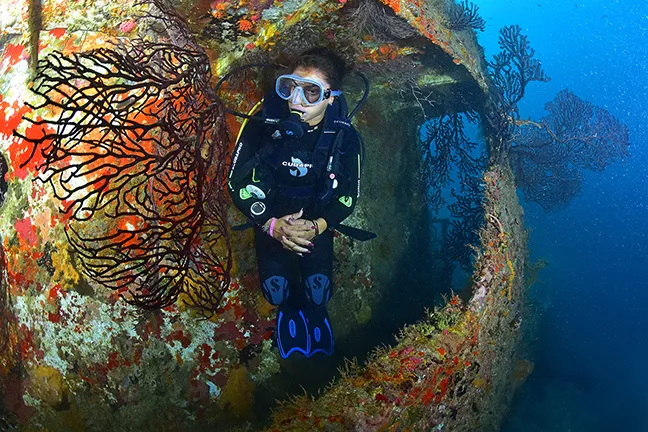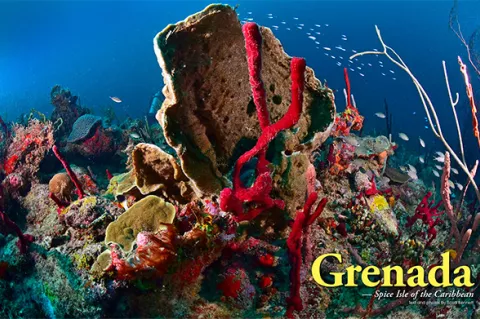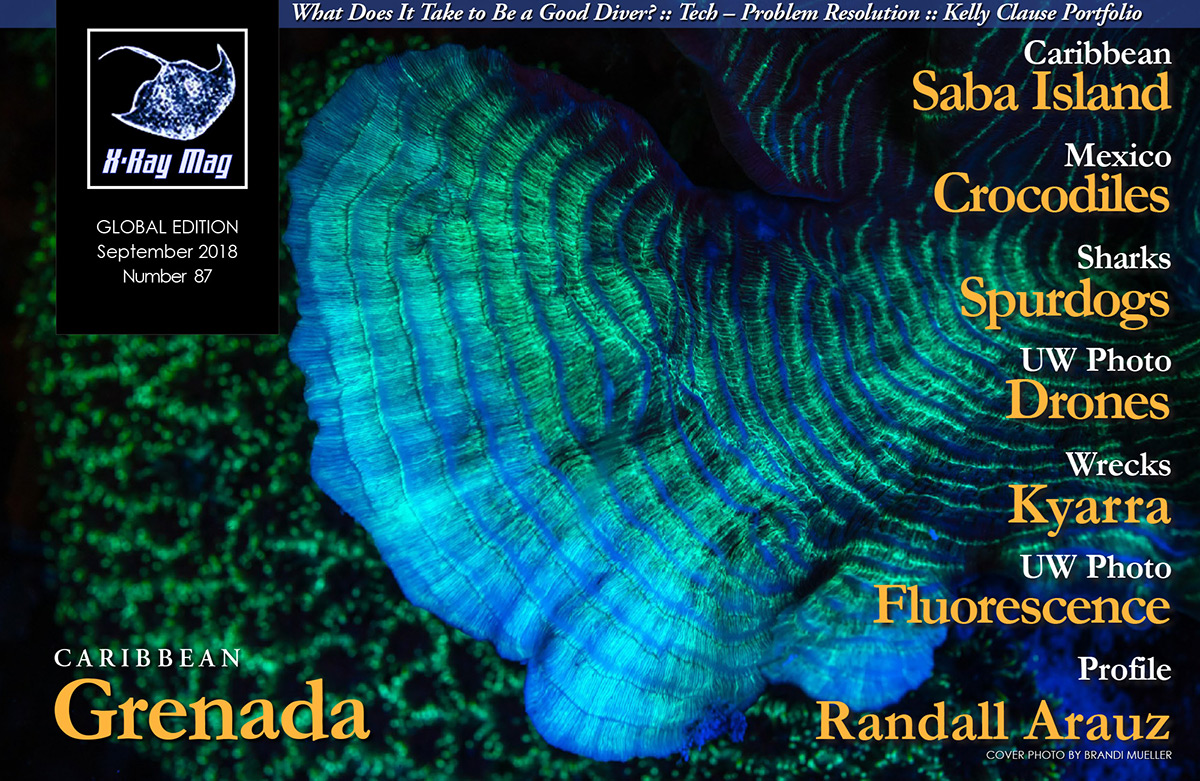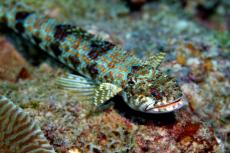Anchored at the southern end of the Grenadines in the southern Caribbean, Grenada, known as the "Island of Spice" due to its nutmeg and mace production, has long been on my radar. Being tropical and scenic with good diving and a short flight from home, how could one NOT be enticed? Alas, circumstance always seemed to intervene, making it a destination for "next year." But with a gap in my calendar before Christmas, I decided it was finally going to be "this year." The impending Canadian winter provided added incentive!
Contributed by
Although Air Canada offers non-stop flights from Toronto on Mondays, the flight was nearly full and expensive. Instead, I opted to fly Caribbean Airlines via Trinidad, which offers daily connecting flights to Grenada's Maurice Bishop International Airport.
Despite being only a 30-minute flight, Grenada seemed light years away from the bustle of Trinidad. Landing at 8:30 a.m., mine was the only flight in the entire airport. Within minutes, I had my luggage and was out the door, where Peter Seupel, owner of Aquanauts Grenada, was waiting. "Welcome to Grenada!" he enthused, and with my bags loaded on his truck, we headed for Aquanauts' base at the True Blue Bay Resort, a 7-minute drive away.
Dive centre and resort
My home for the week, the True Blue, was a beautiful boutique hotel located on True Blue Bay (and painted blue to boot). Near reception, an activities board announced the week's events. Every night featured a theme, from chocolate and rum tasting to Mexican/Caribbean food night and even a street food festival. I was already liking this!
As my room was not quite ready, I headed over to get some breakfast. A focal point of the resort, the Dodgy Dock restaurant was the essence of eclectic cool; open-air and spacious with delightfully quirky décor. Fresh fruit juice and an omlette was just the ticket. The nutmeg banana bread was amazing; then again, I wason the island of spice. An hour after landing, I had already checked in at my hotel and eaten breakfast. How cool is that?
Only metres from the reception, my room was a two-level affair, with living room/ kitchen on the main floor and bedroom/bathroom on the second. Each floor had a terrace, with views across the bay to St. George's University.
After unpacking, I ventured to the dive shop to get my gear sorted out. Peter and his wife Gerlinde founded Aquanauts back in 1997. After operating a dive centre in Curaçao, they wanted to move on. After some island hopping to find another place, a short stopover in Grenada caught their attention. "Grenada was not really on our minds, but what got us immediately was the friendliness of the people and the beauty of the island. The diving was not much developed, so we saw a great opportunity there."
From wrecks to reefs, some 31 sites are located off and along the island's southern coast, with something for every skill level. Grenada is renowned as the wreck dive of the Caribbean and that is no idle boast. Around 15 separate wrecks can be found off the island's southern coast, with three along the rougher Atlantic side. With a week at my disposal, I looked forward to seeing a broad spectrum of Grenada's dive sites.
Unfortunately, I was unable to buy a wetsuit before my departure and all the shop had available was a shorty. With gear sorted, I met the Aquanauts crew. On hand were dive guides Bruce, Myron, Chrispin and Roland AKA Bugsy. Aquanauts predominantly uses nitrox, but those using rebreathers are also well-catered to.
Prior to departure, I had quite a shock. As I was about to immerse my housing in the rinse tank, DM Paul was beside me, inspecting his rebreather. As my housing hit the water, a loud "beep, beep, beep” froze me, google-eyed. Fortunately, it was only his rebreather, but it jolted me faster than a double espresso shot!
Above the dive shop entrance was a sign offering frozen lionfish fillets for sale. The fish had become the scourge of the Caribbean since their accidental release, and Aquanauts was doing its part to alleviate the situation. Chrispin was coming along with his trusty speargun to stock up the freezer.
Diving
Shark Reef. Housing assembled, I headed back to the dive centre for the 2:00 p.m. departure. With Captain Larry at the helm and DM Myron as my dive buddy, we set out for Shark Reef, located off the island's exposed Atlantic side. In contrast to the sheltered Caribbean Sea, where most of the dive sites are situated, conditions can be more challenging, with rougher seas and strong currents. The site itself is over 3km long, averaging depths between 10-13m. Dives are generally done as drifts.
En route, conditions were unsettled, with wind and surface chop but the trip was less than 10 minutes. For the ensuing hour, the current moved us along, although it was possible to slow down to take photos. Aggregations of porous sea rods were interspersed with giant and netted barrel sponges, pillar corals, common sea fans and rough tube sponges. Within minutes, we found our first nurse shark resting on the bottom. I managed one shot before the current pushed me away. Many of the fish were species I had not seen before, including rock beauty angelfish, reticulate moray, longspine squirrelfish, stoplight parrotfish, the orange phase of a whitespotted filefish, blueheads and a pair of purplemouth morays.
I also found a lionfish, but Chrispin promptly appeared and voila: one more for the freezer. A giant barrel sponge revealed a pair of banded coral shrimp, while a mixed school of French and Caesar grunt along with three great barracudas and a huge hawksbill sea turtle kept me enthralled. I also had my first run-in with branching fire coral (it won) and immediately regretted not buying a long wetsuit before leaving home. Regardless, it was a great dive to begin the week and I could not wait to see what else Grenada had in store.
Windmill Shallows. The next morning, I was rested, fed and eager for a full day's diving. First up was Windmill Shallows, a reef with drop-offs ranging from 18m to 32m. Consisting of a narrow ridge 9m wide, the seaward side featured a slope descending to 140ft before turning into a wall. Whip corals, gorgonians, vase, rope and barrel sponges thrived, while deepwater sea fans crowded the slope. Yet more barracuda appeared; I do not think I have ever seen so many in such a short time! Their claws outstretched, huge channel-clinging crabs peered from crevices as longspine squirrelfish, butterflyfish and creole wrasse swarmed in abundance. Great stuff!
Veronica L. But things only got better. Next up was a site that quickly became a favourite: the Veronica L. A small cargo vessel that sank outside St. George's, the vessel was relocated to its current position near Boss Reef as the original site was prone to silting from a nearby river. A shallow dive no deeper than 12m, we headed straight for the stern, where a spotted moray was swimming out in the open. I managed a couple of shots before it vanished into a nearby recess. The vessel was so encrusted with growth it bore the appearance of a ship sculpted from sponges, with virtually none of the original structure visible.
And then there was the marine life. The open hold housed congregations of French grunt, along with longspine squirrelfish, sergeant majors and the occasional Atlantic trumpetfish. On deck, coral-shrouded machinery included a crane with a 6m arm. The crane was a fish magnet, with large numbers of brown chromis, along with juvenile blueheads, striped parrotfish, banded butterflyfish, porcupinefish and yellowtail snappers. Mutton snappers kept their distance farther down the deck. The port side revealed dense congregations of cup corals as fireworms skittered about. With next to no current, this was one of the best wrecks I have ever dived. Shooting upwards in the shallow water insured a blue backdrop to the teeming fish life and vibrant growth; underwater photography does not get any better!
Bianca C. The next morning, our first dive would be at one of Grenada's most renowned sites. Calling the Bianca C the "Titanic of the Caribbean" is no exaggeration. At 180m in length, the 18,000-ton cruise liner sank in St. George's Harbour on 22 October 1961 due to an explosion in the boiler room. The ensuing fire prompted the evacuation of over 400 passengers and 200 crew. Of those aboard, 672 of 673 people were saved by the prompt actions of the crew and numerous local boats that arrived to help. After burning for two straight days, a tow line was secured to remove her from the local shipping lanes. However, a sudden squall severed it and she sank to the bottom, about 3km from Grand Anse Beach.
Resting upright on her keel at 50m, the vessel has been gradually collapsing in on itself over the last few decades. According to Peter, breaks in the hull have widened and decks have collapsed over the years as the vessel continues settling. Around 1994, the ship's rear third broke off and toppled onto its starboard side. One of the swimming pools was destroyed, but the forward pool remains intact.
Strong currents and the depth ensure this is a dive for advanced divers only. Bruce recommended a negative entry followed by a quick decent. Fortunately, currents were mild, and it was an easy swim. The first sight of the Bianca was decidedly eerie. Descending into the blue, it only becomes visible around 25m, its silhouette emerging like an immense ghost. We headed for the stern, where a trio of great barracuda scattered at our approach. Even the stern's uppermost section was at 35m, so I was thankful for the nitrox.
Unfortunately, there was no time to linger. Just swimming from the stern to the bow utilised a good chunk of bottom time. The biggest wreck I have ever dived, the scale was difficult to grasp. It is so big, it cannot be seen in its entirety; and in places, resembled a massive underwater plateau capped with sponges and corals. Photography proved a challenge and having a diver in the shot was necessary to show the immense scale. This was a dive that definitely warrants repeat visits.
Purple Rain. Our second dive was at another of Grenada's signature sites. Running parallel to the coastline, Purple Rain was not named after the late pop superstar, but for the profuse numbers of violet creole wrasse. Another beautiful reef, sponges in a plethora of sizes mingled with abundant fan and brain corals. Vase sponges proliferated in hues of purple, pink and cream along with porous sea rods and those ever-so-pesky fire corals. Unlike other reefs impacted by coral bleaching, Grenada's reefs were healthy and thriving. It was difficult to know where to aim the camera.
Topside excursions
Grand Anse Beach. Back at the resort, Peter had arranged for local photographer Arthur Daniel to take me out for some topside shooting. First stop was Grand Anse Beach, Grenada's most famous. Unlike on other islands where the best beaches are reserved for well-heeled vacationers, Grand Anse is open to tourists and locals alike. Even in late afternoon, the beach was thronged. Arthur's car, a sleek Toyota Altezza, quickly proved to be a local celebrity. Returning from the beach, we found a gaggle of schoolkids posing for selfies in front of it!
St. George's. We then headed for St. George's, the island's capitol. Founded by the French in 1650 and named Ville de Fort Royale, the town was built to replace the original settlement of Port Louis, as it proved to be subjected to flooding and malaria. Ceded to the British by the Treaty of Paris in 1763, it was renamed Saint George's Town after Britain's patron saint. One of the Caribbean's most picturesque towns, it occupies a dynamic location encircling a horseshoe-shaped harbour surrounded by the slopes of an old volcanic crater.
En route, we stopped at a lookout well off the tourist path. After a steep, uphill hike, we came across a lookout offering spendid views across the harbour to the town. Looking like a miniature San Francisco, a delightful jumble of architectural styles and pastel hues cascaded along the steep hillsides. Fortunately, there was nary a high-rise or mega resort in sight, although a six-star resort is under construction near Grand Anse Beach. Below in the harbour, mega yachts mingled with small fishing boats. One yacht had the tallest mast I have ever seen, towering above an adjacent cruise liner. Another was "The Maltese Falcon," the world's most expensive sailing yacht, whose astronomical price tag exceeds the GNP of many countries.
We then headed around the bay towards the city centre. After miraculously finding a parking spot, we set out to explore on foot. Some of the oldest buildings are churches, with the French built the St. George's Cathedral (1818) and the English St. George's Anglican Church (1825). At one intersection, a policeman directed traffic from an elevated box, like a human traffic light. The town was a photographic delight, with photo ops at every step.
However, what was appealing to the camera proved less so to the leg muscles. Ahead, the road plunged precipitously, with parked cars looking like they would topple over. "Please tell me we aren't walking back up this hill," I said to Arthur with thinly veiled trepidation. Laughing, he assured me we would not. Instead, we took a circular route to end up at Fort George and then back to the car.
Fort George. Strategically positioned overlooking the harbour, Fort George has seen many events in the island's history, but a recent one stands out. It was here in 1983 that Prime Minister Maurice Bishop was executed, prompting the American-led invasion several days later. To this day, bullet holes remain clearly visible in the walls. Watching a glorious sunset as the city's lights twinkled to life, a siren wailed. "That's the 6:00 siren," explained Arthur. "Every day at both 6:00 a.m. and p.m., the fire department sets off the siren. It's been a tradition since I was a boy."
Street Food Wednesday. We made it back to True Blue in time for Street Food Wednesday, when local eating establishments set up to offer a selection of street foods from Grenada, the Caribbean and Mexico. Arthur knew each vendor and, after introductions, provided me with a full rundown on the dishes offered. With each offering up to a dozen dishes, that was upwards of 60 different choices. As a die-hard foodie, I was in culinary heaven!
After purchasing tickets in various denominations at the door, I could trade these for the food, which came in a variety of prices depending on whether they were meat, seafood or veg. We decided to share, so I could sample as many different items as possible. I was intrigued by the local dishes, many of which I was unfamiliar with. Oil down, Grenada's national dish, is a one-pot meal of salted meat, chicken, dumplings, breadfruit, callaloo (made from young dasheen leaves) and other vegetables stewed in coconut milk, herbs and spices. With my brain over-saturated with choice, I presented Arthur a handful of tickets and asked him to choose.
Shortly afterwards, we feasted on a mouth-watering spread of oil down, mutton curry, pilau rice, macaroni pie, steamed fish, grilled chicken and lionfish. Accompanied with a Dockside Ale from the West Indies Brewing company, it was an amazing meal. Remarkably, I had room left for some nutmeg ice cream. Barely…
More diving
The remainder of the week was spent doing two to three dives a day, visiting a variety of sites from reefs to wrecks. Frequent squalls would come and go, with torrential rain quickly followed by blue skies. Due to the unsettled conditions, diving the Atlantic wrecks proved impossible, but there was no shortage of outstanding sites to explore.
Black Forest. Black Forest was another luxuriant reef, resplendent with deepwater sea fans and a variety of sponges including rope, pillar, vase, elephant ear and giant barrel sponges. Foureye butterflyfish, stoplight parrotfish, brown chromis and maddeningly shy barracudas were joined by a French angelfish and a huge green moray.
Spice Island Reef. Spice Island Reef featured a sandy area bordered by a reef of finger and brain corals. It was a hard-coral reef, the small bommies providing an ideal habitat for juvenile fish as well as yellowtail snapper, blue chromis and numerous sea plumes.
Grenada Marine Park. After several days shooting wide-angle, I was eager to concentrate on the smaller picture. Located past St. George's, the Grenada Marine Park featured a pair of superb macro sites. Permits were required, which Peter handed out as we geared up. The reef's innermost section is also home to Grenada's Underwater Sculpture Park. Unfortunately, poor visibility meant we had to give it a miss.
Flamingo Bay. Fortunately, bad vis proved no hindrance to macro. First up was Flamingo Bay and it did not take long to find obliging subjects. Right away, we found a tiny blenny peering from a burrow, which I initially thought was a secretary blenny. Exceedingly tolerant, it allowed frame-filling portraits with my macro lens. Checking a Caribbean fish guide later, I realised it was a sailfin blenny, a species I had never seen before. We found three more, along with Pederson cleaner shrimp, harlequin bass, flamingo tongue molluscs and banded jawfish.
I then noticed a great barracuda, which appeared more curious than normal; Bruce had to swat it away after it came a bit too close for comfort. In a classic case of Murphy's Law, this was the week's sole instance where I was within touching distance of a great barracuda and I had a macro lens on the camera! Large colonies of brown garden eels thrived in the sandy areas and with a slow approach, I was able to get close enough for photos.
Molinere Reef. Descending from 6m to 28m, Molinere Reef proved to be equally photogenic. Interspersed with a succession of gullies and sand channels, hard and soft corals thrived along with a colourful medley of sea rods and sea plumes. Lying on her side near the wall's base, I could just discern the silhouette of the Buccaneer, a 12m steel schooner. Alas, I was so engrossed with macro photography, I did not quite make it.
With the daily tally of burns and contusions on my legs multiplying, I was really attempting to be more careful. Spotting a yellowhead jawfish, I analysed my surroundings before settling on a sandy patch. Suddenly, my knee felt a familiar burn. Wincing, I promptly found the culprit; a mere sprig of fire coral protruding from the bottom. Naturally, I had to brush against the only specimen in the immediate vicinity!
Observing the jawfish, the irritation was promptly forgotten. Although I missed a shot of him out of his hole, I discovered something even better. His mouth was chockfull of eggs! Moments later, Bruce yielded another surprise: a longlure frogfish. It was the first one I have ever encountered that was green. Back on the boat, Bruce said it had been six months since a frogfish had even been seen.
Back to the Bianca C and Shark Reef
A return visit to the Bianca C saw Peter as my dive buddy and we descended the stern to 41m, where clusters of black coral could be found. Swimming to the bow, we headed for the swim-through beneath the upper deck, where I came uncomfortably close to decompression limits. Another visit to Shark Reef revealed a trio of southern stingrays along with hawksbill sea turtles, barracudas, spotted drum and a half-dozen lobsters.
More topside activities
Fort Fredrick. On another afternoon, Arthur took me out again for some land photography. Our first stop was Fort Fredrick, the best-preserved of St. George's trio of forts. Occupying a commanding position atop Richmond Hill, it was constructed by the French in 1779. Commandeered by the British, it was ironically used in defence against the French, although a cannon was never fired in anger.
With
Chocolate Museum. Back in St. George's, we stopped in at the Chocolate Museum. The equivalent of the mothership calling me home, I knew my wallet would not make it out unscathed. Arthur had designed the museum's interior and I was impressed. The displays were informative and attractively presented, lots of interesting info about the island's chocolate production. And then came the gift shop. A cornucopia of products beckoned, from chocolate bars and raw cacao nibs to chocolate chili sauce, nutmeg and ginger BBQ sauce, flavoured coffee and spice packets of nutmeg, mace and cinnamon. My instincts were proven correct, as I departed with a few bags of goodies. After all, how could one refuse Forbidden Chocolate flavoured coffee?
Heading back to the car, Arthur wanted to show me some scenic viewpoints, this time facing towards Fort George. We finished up at another outstanding sunset location just in time for the 6:00 siren. The light was exquisite!
MV Shakem
With another wreck, MV Shakem, on the agenda, Peter had arranged for former Aquanauts employee, Grenadian-born Tatiana Costantini, to join us. She was an experienced model, who has worked with many other photographers.
A 55m freighter, the Shakem capsized in May 2001 after its cargo of cement shifted during a storm. Virtually intact and resting upright at 32m, the decks are situated at around 25m. A dense mantle of marine life has since enveloped the vessel, including spectacular swathes of white Telesto soft coral. Massive bags of cement remain strewn across the open cargo hold, while deck machinery and a crane played host to an abundance of fish, including French grunts and sergeant majors. Tatiana proved to be a superb model, instinctively posing in all the best spots. Shots of her looking down the ladder and peering from behind the Telesto were quick favourites.
Back in the room, I had unexpected company. While reaching into my toiletry bag, a tiny lizard, jumped on to the rim. Naturally, I ran for my camera. After snapping a few images, I tried coaxing him onto my hand, so I could take him outside. Instead he jumped onto the side of my head! Not wanting to hurt it, I headed outside where I intercepted a passing staff member. "Excuse me, can you remove this lizard form the top of my head?"
Land excursion
With diving (sadly) finished for the trip, Peter had arranged for Bugsy to take me for a land excursion on my final day. I quickly discovered the island's compact size of 306 sq km has absolutely no bearing on how long it takes to get anywhere. Grenada is one of the hilliest places I have ever seen.
Not far from True Blue Bay, Bugsy pointed out Calivigny, the world's most expensive private island resort. The entire 10-suite island can be yours for a mere US$120,000 a night (then again, it does sleep 50 people). Passing the turnoff to St. George's, we headed up the island's rugged spine. "Everyone has a view on Grenada," enthused Bugsy, and he wasn't kidding. It seemed every house had a million-dollar view. I realised the island's longest stretch of straight road was from the roundabout to the True Blue Resort.
Grand Etang National Park. After a brief stop at Annandale Falls, the road rapidly gained elevation, with lush rainforest enveloping the landscape. Ascending to 582m, we entered the Grand Etang National Park. A 1,000ha swathe of mountainous forest, the name translates as "large lake" in French, referring to the 12ha crater lake within the park boundaries.
Prior to the Grand Etang Lake turnoff, Bugsy mentioned there was usually a fellow with a Mona monkey posing for photos. I normally avoid such touristy things, but I really did want a monkey photo. Found in West Africa, they were likely introduced during the years of the slave trade. Sadly, being a Sunday with no cruise ships in port, he was not there. Instead, we headed to the crater lake for a photo stop.
Heading back to the main road, a van blocked our way, with a group of tourists standing alongside it. Suddenly, I glimpsed a tail. Mona monkeys! Even better, these were wild. Well, not entirely wild, as one was perched atop a lady's shoulder eating a banana. At the best of times, monkeys are not my favourite creatures, especially those used to people. Amazingly, these were different. Colourfully patterned with round furry faces, they were very gentle. Banana finished, it then jumped from the lady to me, clambering down me like a ladder before scurrying up a nearby tree!
River Antoine Rum Distillery. For the remainder of the tour, I got to visit two of the island's mainstays: rum and chocolate. It is remarkable that an island of just over 110,000 people has five rum distilleries and River Antoine is the island's oldest, dating back to 1785. Although rum tasting was closed, we were able to freely wander around observing the entire process, from the harvesting of sugar cane to the fermentation in huge bubbling vats. The sickly, sweet smell of the latter was almost enough to turn me off rum entirely (I did say almost). At 70 percent, Rivers Rum is so potent, it is not allowed out of the country!
Diamond Chocolate Factory. At the Diamond Chocolate Factory, makers of Jouvet chocolate, I had a plantation tour during which I was able to see the ripe cacao pods growing. Although the factory was closed, the gift shop beckoned. The nutmeg and ginger varieties were especially delicious. And yes, I bought more chocolate.
Charlies Bar Wall of Tires. The drive back revealed scenic coastal views and one quirky man-made one. Outside of St. George's, Charlies Bar had constructed an enormous wall of tires, all painted in Grenada's national colours of red, green and yellow. Originally made to entice customers, it is now an attraction in its own right, with many tyres inscribed with facts about the country.
Christmas market. Back at the resort, I made it just in time for the annual Christmas market, with vendors selling a wide variety of crafts and products. A great finish to a great day (but no more chocolate).
Final thoughts
My trip at an end, I was equally sad and happy. Sad to be leaving, but happy for the privilege of visiting such an extraordinary place. Even in a week, there simply was not enough time to experience everything on offer. Along with the outstanding diving, the myriad of topside attractions makes the island an ideal destination for those travelling with non-divers. Having missed out on the Underwater Sculpture Park and the Atlantic wrecks, I knew a return visit was in order. I could see why many of the guests at True Blue are repeat visitors; I intend to be one myself!

